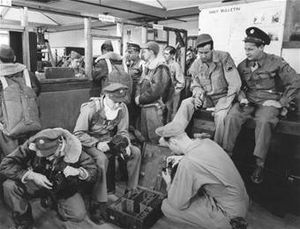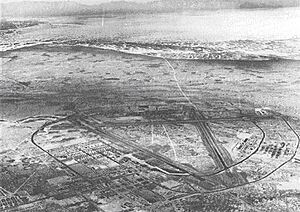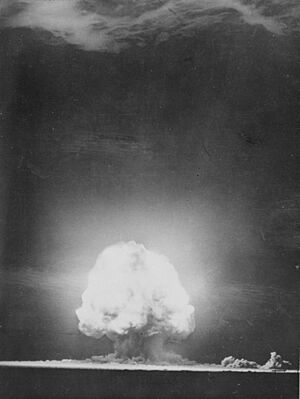New Mexico during World War II facts for kids
Quick facts for kids New Mexico during World War II |
|
|---|---|

Young soldiers learning to use cameras for bomb-spotting missions at Roswell Army Flying School.
|
|
| population | 531,818 (1940) |
| Date | 1941–1945 |
| Casualties | ~2,349 |
| Events | The Lordsburg Killings – July 27, 1942 The Escape from Fort Stanton – November 1–3, 1942 The Bat Bomb Incident – May 15, 1943 The Santa Fe Riot – March 12, 1945 The Trinity explosion – July 16, 1945 |
New Mexico went through huge changes during World War II. When America joined the war in 1941, New Mexico became a key place for creating nuclear weapons. It also became an important base for the United States Army. Many more people moved to New Mexico during the war and in the years after. This time is called the "Boom Years" in New Mexico's history. In 1940, about 530,000 people lived there. By 1960, that number grew to over 950,000. The new military technology also created a special connection between New Mexico, the government, and scientists. This connection is still strong today.
Contents
How New Mexico Helped in World War II
New Mexico's Brave Soldiers
World War II lasted almost four years for the United States. During this time, 49,579 men from New Mexico joined the military. New Mexico had the highest number of volunteers and the highest number of soldiers lost in battle among all 48 states.
New Mexican soldiers were among the first Americans to fight in the war. Hundreds of soldiers from the 200th Coast Artillery, part of the New Mexico National Guard, were in the Philippines. They were operating anti-aircraft guns at Clark Field and Fort Stotsenburg. These bases were bombed by Japanese planes just ten hours after the attack on Pearl Harbor in Hawaii. The New Mexicans found it hard to hit the high-flying Japanese bombers. But they did shoot down some low-flying fighters.
After Japan started its main attack to take over the Philippines, the 200th Coast Artillery and New Mexico's 515th Coast Artillery helped American and Filipino forces retreat. This happened during the Battle of Bataan, which ended on April 9, 1942. The New Mexicans then had to endure the Bataan Death March. Thousands of Allied prisoners of war died during this forced march. They were moved from the battlefield to camps at Balanga. Only 800 of the 1,800 New Mexican troops in the Philippines returned home.
Many famous Navajo code talkers came from New Mexico. The Marine Corps needed a way to send secret messages that the Japanese could not understand. So, they created groups of Navajo radiomen. These men used their native language as a code on the battlefield. The first group had 29 men. They were recruited by Philip Johnston, a World War I veteran who spoke Navajo fluently. Johnston and these "original twenty-nine" created the code. Others later improved it as the war continued.
At least 540 Navajos served in the Marine Corps during World War II. About 400 of them were trained as code talkers. Many recruits did not have birth certificates, so their exact age was hard to check. After the war, it was found that some boys as young as fifteen had joined. Navajo code talkers fought in every major battle of the Pacific Theater from 1942 to 1945. This included places like Guadalcanal and Okinawa. Their simple messages saved many lives and helped end the war faster. Their code was never broken. It was even used by American forces in the Korean War and early Vietnam War.
Military Bases in New Mexico

Several military bases were built in New Mexico right after the war started. These included airbases, prisoner of war (POW) camps, and internment camps. One of the most important new bases was Kirtland Field in Albuquerque. Kirtland was first a flight school for Air Corps pilots. But it became a major base after the attack on Pearl Harbor. By 1945, 1,750 B-24 crewmen had trained there. Also, B-29 pilots, AT-11 pilots, glider pilots, aviation mechanics, and navigators trained there.
In May 1942, the army built the Albuquerque Air Depot Training Station near Kirtland. This place trained people to service, repair, and maintain aircraft. However, it soon became an airbase itself. It was used as a recovery station for wounded soldiers coming back from battle. In 1945, it was renamed Sandia Army Airfield and later joined with Kirtland. Other big bases were in Clovis, Alamogordo, and Roswell. There were also temporary wartime airfields in Hobbs, Deming, Fort Sumner, and the White Sands Proving Ground.
New Mexico had some of the largest POW camps and internment camps in the United States during World War II. Most prisoners were Germans captured during the North Africa Campaign. There were also some Italian soldiers. Camp Roswell, next to Walker Army Airfield, held 4,800 Germans and Italians. Camp Lordsburg, near the town of Lordsburg, also had Germans and Italians. It also held about 600 Japanese internees. Another 1,900 Japanese internees were at Camp Santa Fe, near the capital city of Santa Fe.
Life at the camps was usually calm. However, there was an incident in 1942. Two Japanese internees were shot and killed at Camp Lordsburg. There was also a "small riot" at Camp Santa Fe in 1945. At least one notable escape attempt also happened. Four sailors, captured from the SS Columbus in 1939, escaped from the German internment camp at Fort Stanton. This happened on the night of November 1, 1942. They headed south towards Mexico. They only made it fourteen miles before a group of local people caught them. This happened after a short fight inside the Lincoln National Forest.
Amazing Military Technology
New Mexico became a hub for developing top secret military technology during the war. Two very important scientific breakthroughs happened in the state. There was also a funny, but interesting, event involving the use of Mexican free-tailed bats as a weapon. This was called the Bat Bomb Incident. It happened in 1943. Dr. Lytle S. Adams wanted to attach tiny explosives to bats. The idea was to use them as bombs against Japanese cities.
During testing of this "weapon" at the Carlsbad Army Airfield, some bats accidentally got away. They flew under a fuel truck. The explosions that followed "burned the test range" and set some buildings on fire. Luckily, no one was hurt.
The proximity fuse was another important invention. This fuse was attached to artillery shells. It made them explode when they were close to a target, not just when they hit it. Testing of these anti-aircraft shells began at Kirtland Field as early as 1943. On a nearby desert mesa, the army hung aircraft from "the tallest wooden towers in the world." They then fired the shells at them. The fuses worked very well. They were used with great success against Japanese aircraft in the Pacific. They were also important in Europe during the Battle of the Bulge at the Siege of Bastogne.
The most important secret weapon program in New Mexico was the Manhattan Project. This was the secret name for the nuclear weapon experiments happening across the United States, Canada, and Britain. It started in 1942. Physicist J. Robert Oppenheimer brought together "the greatest concentration of scientific resources and brainpower in history." Their goal was to build the world's first atomic bomb. To do this, the government had the army build the huge Los Alamos National Laboratory. It was 20 miles northwest of Santa Fe. They sealed off the entire area in 1943 to keep it a secret. By the end of the war in 1945, about 5,000 people lived at Los Alamos. This led to the founding of the town we know today.
New Mexico's War Losses
New Mexico paid a high price in World War II. Many brave men from the state lost their lives. The tables below show the number of soldiers from different counties and military branches who died or were missing.
- Army and Air Forces
| County | Killed in Action (KIA) | Died of Wounds (DOW) | Died of Injuries (DOI) | Died, Non-Battle (DNB) | Finding of Death (FOD) | Missing in Action (MIA) | Total |
|---|---|---|---|---|---|---|---|
| Bernalillo | 160 | 12 | 1 | 163 | 17 | 1 | 354 |
| Catron | 6 | 2 | 4 | 2 | 14 | ||
| Chaves | 58 | 4 | 23 | 7 | 1 | 93 | |
| Colfax | 27 | 4 | 25 | 5 | 61 | ||
| Curry | 29 | 5 | 43 | 5 | 2 | 84 | |
| De Baca | 7 | 3 | 7 | 1 | 18 | ||
| Dona Ana | 53 | 3 | 1 | 28 | 12 | 1 | 98 |
| Eddy | 54 | 6 | 53 | 3 | 116 | ||
| Grant | 55 | 5 | 43 | 3 | 2 | 108 | |
| Guadalupe | 15 | 4 | 10 | 29 | |||
| Harding | 8 | 2 | 3 | 13 | |||
| Hidalgo | 9 | 1 | 4 | 14 | |||
| Lea | 27 | 5 | 29 | 4 | 65 | ||
| Lincoln | 21 | 12 | 1 | 34 | |||
| Luna | 26 | 4 | 1 | 21 | 5 | 1 | 58 |
| McKinley | 51 | 6 | 41 | 5 | 103 | ||
| Mora | 29 | 3 | 9 | 41 | |||
| Otero | 19 | 1 | 15 | 2 | 37 | ||
| Quay | 12 | 4 | 7 | 1 | 24 | ||
| Rio Arriba | 32 | 1 | 20 | 7 | 60 | ||
| Roosevelt | 22 | 3 | 17 | 3 | 45 | ||
| Sandoval | 21 | 4 | 15 | 1 | 41 | ||
| San Juan | 22 | 6 | 14 | 3 | 45 | ||
| San Miguel | 42 | 5 | 22 | 2 | 71 | ||
| Santa Fe | 59 | 6 | 47 | 5 | 117 | ||
| Sierra | 14 | 1 | 7 | 3 | 25 | ||
| Socorro | 23 | 4 | 9 | 36 | |||
| Taos | 36 | 6 | 26 | 1 | 69 | ||
| Torrance | 17 | 4 | 10 | 2 | 33 | ||
| Union | 16 | 1 | 10 | 4 | 31 | ||
| Valencia | 46 | 5 | 31 | 82 | |||
| State at Large | 7 | 3 | 2 | 1 | 13 | ||
| Total | 1,023 | 120 | 3 | 771 | 105 | 10 | 2032 |
- Navy, Marine Corps, and Coast Guard
| Type | Total |
|---|---|
| Killed in Action (KIA) | 219 |
| Killed in Prison Camps | 5 |
| Missing in Action (MIA) | 7 |
| Wounded in Action (WIA) | 330 |
| Released from Prison Camps | 19 |
| Total | 580 |
Images for kids
-
A special bookmobile visiting the school at Llano San Juan in December 1941. It brought books, showed educational films, and sold defense stamps.
-
Three Pueblo Indians watching tourists at San Ildefonso Pueblo, New Mexico. This photo was taken by Ansel Adams in 1942.
-
Questa, New Mexico in 1943.
-
A Santa Fe Railroad train, the "Super Chief," being serviced at the depot in Albuquerque in March 1943.
-
General Leslie Groves and J. Robert Oppenheimer at the site of the Trinity explosion in September 1945.












